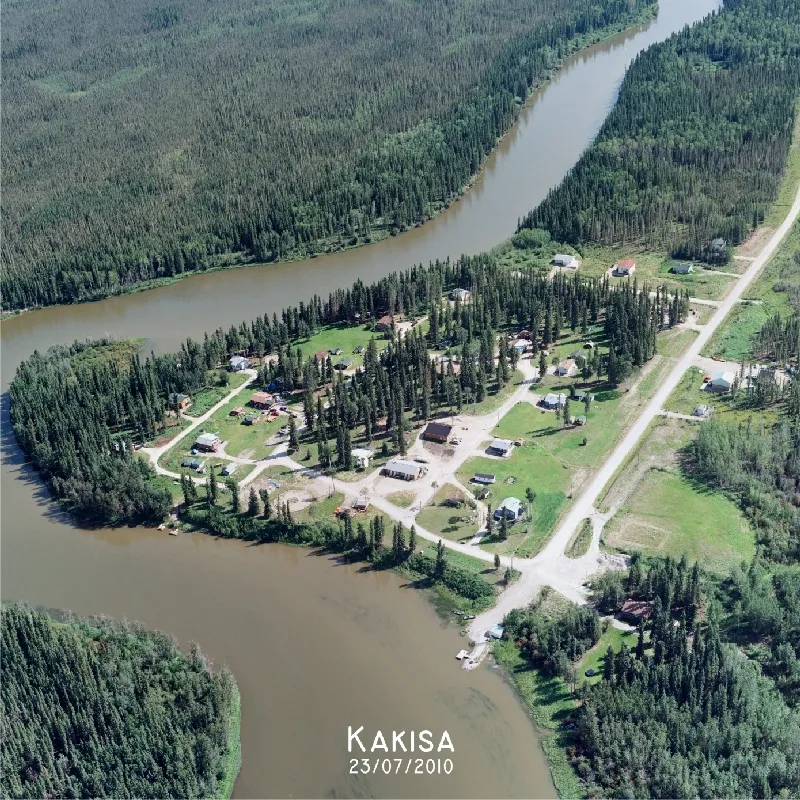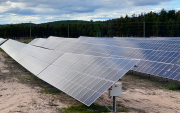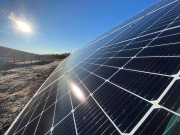Kakisa is a small community in the Dehcho Region of the Northwest Territories (NWT) that is surrounded by natural beauty. Protecting the environment and using renewable energy are not new concepts to the people of Kakisa — we are comfortable living and working in the bush, and gathering wood for the stoves that heat our homes. With the cost of living in Kakisa being very high, it’s important for community members—both youth and elders—to be aware of opportunities that save money and also benefit the environment.
For example, public buildings in Kakisa are heated using fuel oil, which comes at a significant cost to the community — about $42 per Gigajoule. This produces a lot of carbon pollution and risks polluting the land with fuel spills. In comparison, the cost of cordwood is about $17 per Gigajoule, and is renewable, making it better for the climate. Renewable energy options like cordwood and biomass have a lot of potential for the North, not only for the cost savings and the environmental benefits, but because they can help our communities become more self-sufficient.
This was one of the reasons that the Pembina Institute, Arctic Energy Alliance, and Dehcho First Nations teamed up to organize a Dehcho Community Renewable Energy Forum last month in Fort Providence, NWT. About 60 people from eight Dehcho communities were in attendance: Jessica Jumbo, an Environmental Coordinator with Sambaa K’e Dene Band, and myself, an environmental coordinator with K’ágee Tu First Nation (KTFN), sat on the Planning Committee for the Forum.
 The purpose of the Forum was to provide opportunities for Dehcho community leaders and other engaged residents to hear both from the technical experts at the Arctic Energy Alliance about biomass and solar energy options, as well as from our fellow communities about the challenges and the lessons they’ve learned so far when it comes to renewable energy projects that are underway or being planned.
The purpose of the Forum was to provide opportunities for Dehcho community leaders and other engaged residents to hear both from the technical experts at the Arctic Energy Alliance about biomass and solar energy options, as well as from our fellow communities about the challenges and the lessons they’ve learned so far when it comes to renewable energy projects that are underway or being planned.
For me, energy forum workshops are important because they give elders and youth a chance to come together and learn about which energy options are out there, and how they can be used. Sitting on the Energy Forum Planning Committee gave me a lot of insight on energy savings and what types of energy equipment are available.
For example, KTFN is in the process of installing its first biomass boiler system for its Band Office and Store/Motel. There are also plans for a new community building to go up this year, and the Band is thinking of getting both solar panels and a biomass heating system for the new building. A cordwood boiler makes sense for KTFN, since the Band already cleared about 60 cords of wood for fire breaks around the community. Wood is a traditional way of heating homes that has been used for countless generations in a sustainable way, up to the present. It is a method people are familiar and comfortable with. It is also an opportunity to create sustainable long-term employment that encourages KTFN members to keep getting out on the land.
However, there are some big challenges associated with a cordwood boiler. At the scale needed by KTFN, the boiler would require someone to feed the fire every four hours during the coldest times of the year. It’s one thing to feed a fire in the middle of the night in your home; it’s another to trek to the office in the middle of the night in minus 40°C.
 KTFN has chosen a boiler model that has the flexibility of switching to wood pellets instead of cordwood during those times. The automated feeding of pellets into the boiler from a large silo allows the system to keep running on its own for months. The downside of using pellets is the higher cost, with the economic benefits leaving the community and a continued dependency on external sources for fuel.
KTFN has chosen a boiler model that has the flexibility of switching to wood pellets instead of cordwood during those times. The automated feeding of pellets into the boiler from a large silo allows the system to keep running on its own for months. The downside of using pellets is the higher cost, with the economic benefits leaving the community and a continued dependency on external sources for fuel.
Despite this challenge, KTFN hopes this project will ultimately move the community closer to achieving the goals in its 2000-01 Community Development Strategic Plan: "Self-government, self-sufficiency, according to the teaching and principles of the elders," with one of the main pillars of the Plan being the development of a self-sufficient economy.
The Tsou-ke First Nation in British Columbia is also moving towards being completely energy self-sufficient, looking to better energy efficiency and solar power installations to help. We showed this inspirational video, by the Pembina Institute’s Green Energy Futures, during the forum to highlight Tsou-ke’s efforts as a good example of how efficiency and renewables can help communities become more self-sufficient. Another good example is Fort Providence’s efforts to install a district biomass heating system, and participants saw this video by Arctic Energy Alliance that profiles that project.
Renewable energy isn’t new to us; one of the main themes that emerged at the forum was elders’ familiarity with it, based on both age-old practices and earlier innovations. Elders told the story of how, more than 50 years ago, a windmill powered the Hudson’s Bay Company store in Wrigley, a Dehcho community on the Mackenzie River accessible only by winter road. By reharnessing the clean power provided by the sun, the forest, and the land that has always sustained Dene people, northerners can once again reclaim greater self-reliance.
By Melaine Simba, K’ágee Tu First Nation, Kakisa, Northwest Territories with Shauna Morgan, Senior Analyst, Pembina Institute.









